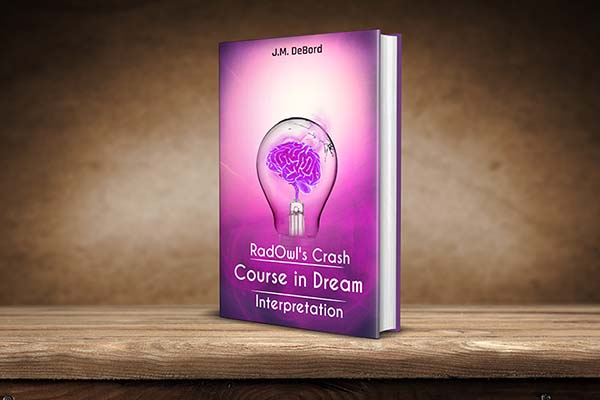Most dreams connect with events, experiences, situations and circumstances of the previous day or two, or anticipate what’s coming up in the next day or two. You don’t need to reflect back to a month or year ago, or look ahead to a month or year from now, because it’s outside the scope of time that dreams usually cover.
Instead, reflect closely on your life and especially on your thoughts and feelings to find the source material a dream uses to create its story. It’s usually found in your memories.
There are exceptions. When you immerse in the study of dreams you always find exceptions. “Week in review” dreams review spans of time of a week or longer, all the way up to “life in review.” They are summations of the past week, month, year or longer of your life. They tend to show past, present, and future in the story, and are highly metaphorical and harder to pin down exactly how they connect with you and your life.
For example, your recent history involves searching for something to inspire you, and a related “review” dream involves castles, monarchs, knights, damsels, dragons, and the Holy Grail. There’s no dream content to trace directly to recent memories, but it really is a story about your life, and if you step back to see that it’s really about finding inspiration, you find the connection with your life. The search for the Holy Grail is an allegory about searching for inspiration, purpose, meaning, and spirit.
You can find the source of some dreams in your deepest inner processes, especially the movement of spirit (your inner self) to find expression in your life, and your development and actualization as an individual. “Individuation”—the process of becoming complete and self-actualized—is a lifetime process. As you mature, your dreams tend to focus more on it, and dream content becomes more personalized as a result.
D3 in action: reflect on your life
By the time you work up to this point you have the information you need to find out how a dream parallels your life. It’s not to say it’ll be obvious, but at least you have something to work with.
By working the D3 steps you have information about the dream’s symbolism and story. You have context that helps you understand what the dream is really saying and how it connects personally with you. You connect the dots around a central idea. Or at least, you’ve tried to. You’ve made the effort, and at this point even if you don’t know what the dream means, the energy you expand feeds back to you.
Now reflect on your recent life. Just… think. Contemplate. Feel. Listen to your heart. Listen to your body.
Use the dream as a starting point for thinking about where you’re at in your life, how you got here, and where you’re headed. Use it like inspiration for a diary and just write (or talk, or ruminate—whatever you prefer). Remember simple fact #1: you already know subconsciously what the dream means. It’ll let you know through your feelings and hunches and insights whether you’re getting hotter or colder as you reflect, but you must give it something to work with.
Your dreaming mind WANTS you to understand it and APPRECIATES your efforts. Carl Jung says the intelligent source behind your dreams is the mind of nature itself, and by working with your dreams you interact with it, and something within you grows and flowers. The initial growth is behind the scenes, in the soil of the unconscious mind, then suddenly it emerges.

Dream content from recent memory
Search your dream content for anything that reminds you of something you recently experienced or that sums up where you’re at in life. When your dreams involve a person you’ve seen recently or place you’ve been to, reflect on it. Test to see if the dream connects with the experience involving that person, place, thing or whatever.
When dreams remind you in any way of something that happened recently, even if just symbolically or from the story, reflect on it. Zero in. Look for parallels. Look for symbols and ways the story is told that remind you of your waking life.
The connections and meaning are found by exploring your related thoughts, feelings, and memories. Go below the surface and notice how you react to the experiences you have in life. Notice what’s really happening inside you. Focus on what’s most important for your development and personal growth.
In my dream life, the story of the dream is where I’m most likely to find the meaning because it reflects the broad themes and most important story lines. But it’s not obvious nor is it easy even with all I know as a dream interpreter, I tell ya, and my dreaming mind makes me work at it. Good.
I like to say that dreams are the story of your life written day by day. Each day of experience adds to your story. Each night you chronicle it in your dreams.
Powerful dreams
Particularly potent and metaphorical dreams can connect with something that happened about a week ago that was the subject of a dream at the time. An outsider is not likely to see the connection between the two dreams—they usually appear unrelated—but you will know intuitively that the recent dream connects with an earlier one, or is part of a series of recurring dreams. These dreams are particularly important to understand because they are like capstones that cover everything you have learned and integrated recently in your life. They address the biggest questions and most difficult issues. You know the dreams I’m talking about. They’re unforgettable.
Day residue in dreams
Your dreaming mind is a translator that takes any input and translates it to symbolism. When you review memories of the day while dreaming, the memories are the input. But occasionally dreams are direct in their references. The “day residue” in dreams generally doesn’t make much of an impact on you. It’s not very memorable for most people. They’re the opposite of powerful dreams.
One reason why you dream is to process memories. A lot more is going on while dreaming than just memory processing, but it is a core function and it’s where I like to begin reflecting. When you recognize residue from your memories in a dream, focus on those memories and the events, situations, circumstances, thoughts, feelings, and emotions involving them.
And keep in mind, sometimes dreams reference memories of something that happens during the day because it needs deeper review by night, or it connects with thoughts and feelings that arose at the time.
Example of day residue
Say that you dream about looking through your postal mail. The scene hews closely with a memory of looking through your mail earlier that day, while awake, obviously. In the dream though you look specifically for a letter from a friend. You reflect on the memories brought up by the dream and suddenly remember that a thought passed through your mind about a friend you haven’t heard from in a long time as you were sorting through the mail. You made a note-to-self to get in touch with the person.
Now you have the connector. The dream brings up the memory because it’s reminding you of your note-to-self, which is associated with the memory of looking through your mail. This sort of memory-to-dream association is the reason behind much of the day residue in memorable dreams. You are reminding yourself of something. So when a dream features a memory that matches closely with your waking reality, begin your search for the source with the thoughts and feelings you experienced when the memory was created.
Identify the source of a dream
Rarely do dreams just replay memories verbatim. Instead, they turn everything into symbolism, and it’s up to you to hunt through your memories and think creatively to trace the symbolism back to its source. That’s half the fun. The dream is a mystery and you are the detective, which means your life is the crime scene—haha!
Dreams can start with something you experienced in your outer life and show how it affects you internally, or they show how your outer life is shaped by your inner one. A two-way street. Most dreams connect with events within you—what you think, feel, and perceive—and how you integrate new information and experience into the existing structure of who and what you are. Begin there and work outward.
Sex dreams can be about integration of something new into your personality. The symbolism derives from sex involving the integration of bodies, minds, and hearts.
Identifying the source of a dream provides a path to understanding it, and the trailhead is found in your recent life. In this sense, your dreams are like a diary. They chronicle your life.
Sometimes, dreams replay events of your waking life as stories told through symbolism. But a common mistake made by people new to dream interpretation is they look only at their outer lives for the sources of their dreams. Dreams tend to focus on inner life and what’s happening below the surface of your awareness. They focus on heart and soul and the person you are deep inside.
Studies have shown that most dreams are accurate representations of your everyday life and reflect everyday concerns. They connect closely with your emotions. Once you know what to look for, it’s not hard to find what they speak to about yourself and your life.
Look for what a dream shows you that’s new, that you didn’t already know. There’s always something new to be learned from a dream, even if it just clarifies or expands on what you already know.
Recurring dreams
Give high priority to your recurring dreams. You can do the most good for yourself and potentially learn more in the long run. Recurring dreams come in a few types ranging from repetitive day residue, to serial recurring dreams, to Groundhog Day dreams that repeat themselves exactly. Use the link above to gain access to an extensive lesson on recurring dreams.
When I have a solid grasp on something that recurs in my dreams, I gain deeper understanding of how it’s used and connects with me and my life. For example, see what I wrote about lottery dreams. Briefly, there’s a lesson embedded in my lottery based on the symbolism of the lottery meaning “set yourself up for success by taking every opportunity.” It was a recurring theme in my dreams. Decoding the meaning helped me understand other dreams with the same symbolism.
Resolution
Resolution is closely tied with reflection. It’s relevant in the way a dream directly suggests something or helps you tap your deeper wisdom or ability, or how it influences the course of future events or connects with them. You can find lessons of resolution here:
“What if?”
Dreams can act as simulations. They help you answer questions, resolve issues, and solve problems. They ask, “What if?”
- What if you marry (or married) your high school sweetheart, or pursue a different career?
- What if your crush takes interest in you?
- What if you win the lottery or become famous?
- What if you further develop a skill or ability?
- What if you make one choice over another?
- What if an estranged friend or relative suddenly reappears in your life?
- What if you are walking down the street and a person suddenly confronts you?
- What if it’s the final moment of a big competition and the ball is in your hands, figuratively or literally?
When no other explanation appears to fit the meaning of a dream, consider the possibility that it’s a simulation. Dreams can preview coming events, acting as dress rehearsals. They can simulate threats and future situations. These dreams can act as launching pads for you to use your imagination to decide and prepare for future events or possibilities. See yourself making the big play, or adeptly handling a situation, or reacting adroitly to the unexpected. It’s the first step to making it happen for real.
In my book Dreams 1-2-3 I recount the dream a college student had about a little boy following him around campus saying the most revolting and shocking things. Like, Exorcist-level revolting. “Demon child” is a fair way of describing the behavior. We really struggled with that dream before realizing it was a learning simulation. Earlier that day in abnormal psychology class he’d learned about severely abused children, and the case studies and anecdotes deeply impacted him. The dream personalizes what he learns.
It’s one thing to learn about something theoretically, and another to have a fully immersive virtual reality experience of it.
I’ve seen this type of virtual reality simulation cover subjects such as:
- Death
- Pregnancy
- Childbirth
- Breakups
- Pursuing a new career or course of study
- Afterlife
- Heaven and hell
- God-like ability to create
A person asked for help understanding recurring dreams about serial killers. The scenes play out like Clarice Starling interviewing Hannibal Lecter in the movie Silence of the Lambs. Danger electrifies the air, and the dreamer realizes the potential for danger in interacting directly with a pathological killer. Yet she’s also fascinated and can see in the mind of the killer. Turns out, the person was studying the pathology of serial killers with interest in making a career out of it. Talk about a dress rehearsal for her job! It’s like the dreams are saying, “if this is what you really want, here’s what you need to know to finalize that decision.”
Then there are precognitive dreams, previews of the future. Learn more about precognitive dreams.
Just because you dream about something that’s upcoming in your life doesn’t mean it’s going to happen that way. Most dreams about the future are forecasts. They reflect tendencies and trends. Like the guy who dreams about the big night out he has planned with his friends for that weekend. He dreams it’s a disaster and his friends bail on him, which is what usually happens when he makes plans with those friends. They bail, or the experience doesn’t live up to the hype, and the dreamer ends up disappointed and questioning himself.
The dream merely reflects what he anticipates. Ultimately, the dream is asking him why he sets up himself for disappointment.
Now, here’s a video lesson where I walk you through the D3 process to interpret a detailed dream.
The experience of dreaming
While dreaming, you are in another place and time with no limits except what you place on yourself. Dreams show not only what you are but what you can be. In fact, some schools of thought view all dreams in terms of what they show you about future potential. Dreaming is an experience of mind, body, and spirit and serves many purposes.
Dreams can be summed up as stories told symbolically but never completely explained that way. There are always elements of the experience which are outside the scope of the conscious mind and what it knows and understands. In the teachings of Don Juan, the dream version of you is your energy body, and the dream world is one of energy and thought. You can know this truth for yourself by becoming aware while your dreaming and learning to focus your attention (and reading The Art of Dreaming by Carlos Castaneda).
The magic of dreaming
Dreaming has a magic and mystery that defies all attempts to explain conventionally. Scientists study dreams and come back with sanitized theories that fail to capture the entirety of the experience. The scientific method is best used for studying matter, not dreams and other experiences of consciousness. Dreams can be studied and examined scientifically but not fully explained.
I hope you are open to the greater possibilities presented by dream phenomena such as telepathy, precognition, and out of body experience (OBE). As you delve into your dreams and work with them and your consciousness evolves, you will experience—while dreaming and while awake—things that fall outside the norm.
According to people who know a lot more about OBE than I do, it’s a regular experience for everyone while sleeping. Bob Monroe, famous for his books about out of body experience, studied the subject like an engineer and discovered that everyone has out of body experiences during the Delta stage of the sleep cycle. I call that stage “dead sleep” because it’s when the brain and body are the least active.
You enter different realities that are just as “real” as the waking one. I’m still learning what these experiences really are. It took a lot of deprogramming though. The reductionist training of my rational mind fought hard against accepting the greater possibilities of dreaming. If that’s where you are at, I advise that you just keep an open mind. Science is supposed to be about open inquiry, and you can’t be open when you close off to possibilities and ignore evidence just because it falls outside the boundaries of the conventional and known.
Final thoughts
Wow, you made it through all the steps and sub-steps of the D3 process, assuming you’ve reached this point after reading from the beginning. It’s a lot to digest. Start applying these lessons and you will catch on quickly. It’s fun and challenging.
You are now ready for the ultimate Jedi dream trick: re-experience the dream in your imagination. Sit quietly and just bring your dream to mind. Step into the memories. Relive them. Say to yourself that you’d like insight about the dream, then pay attention to your feelings and intuition. Allow your brain to take a backseat. Just observe.
Keep your journal handy so you can record anything important that comes to mind. Associate freely, but remember that the meaning and message of the dream are the center of gravity, and everything that runs through your mind should orbit around that point. The meaning of a dream has a gravity that attracts the memories, thoughts, and feelings related to it. Your intuition is happy to guide you there if you allow it. It happens naturally.
Play with the dream. Turn it over in your mind. Imagine alternative outcomes. Create backstory for the characters. Talk with them. Daydream. Allow deeper sources inside you to speak.
Your feelings can tell you more about the meaning of a dream than anything else.
The answers are in your heart more so than your head.
More lessons on dream interpretation
You have noticed by now that I use example dreams generously throughout my lessons. My Crash Course in Dream Interpretation covers the basic points you learn by studying the D3 process, then it uses many examples to show how the process is applied. It’s your next step:
And if you really want advanced teaching and training, I offer it at Dream School. Specifically, the guided dream interpretation course that bundles online courses together with one on one tutoring and examination of your dream life.
Take care, and happy dreaming.



